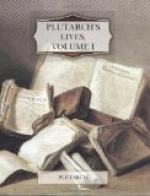“Pythagoras by magic
arts,
And mystic talk deludes men’s
hearts,”
so did Numa invent the story of his amour with a wood-nymph and his secret converse with her, and of his enjoying the society of the Muses. He referred most of his prophetic utterances to the Muses, and taught the Romans to worship one of them especially, whom he called Tacita, which means silent or dumb. This seems to have been done in imitation of Pythagoras, who especially revered silence. His legislation about images was also connected with the Pythagorean doctrine, which says that first principles cannot be touched or seen, but are invisible spiritual essences; for Numa forbade the Romans to worship any likenesses of men or of beasts. Among them there was no image of a god, either carved or moulded, in the early times. For a hundred and seventy years they built temples, and placed shrines in them, but made no image of any living thing, considering that it was wrong to make the worse like the better, and that God cannot be comprehended otherwise than by thought. Their sacrifices also were connected with the Pythagorean doctrine; they were for the most part bloodless, and performed with flour, libations of wine, and all the commonest things. But besides these, there are other distinct proofs of the connection of these two men with one another. One of these is that the Romans enrolled Pythagoras as a citizen, as we are told by Epicharmus the comic poet, in a letter which he wrote to Antenor. He was a man who lived in old times and underwent the Pythagorean training. Another proof is that of his four sons, King Numa named one Mamercus after the son of Pythagoras; from whom sprung the ancient patrician house of the Aemilii. This name was originally given him in sport by the king, who used to call him aimulos or wily. I myself have heard many Romans narrate that an oracle once bade the Romans establish the wisest and the bravest of the Greeks in their own city, and that in consequence of it they set up two brazen statues in the Forum, one of Alkibiades and one of Pythagoras. But all this can be so easily disputed that it is not worth while to pursue it farther or to put any trust in it.




